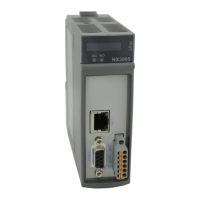5. CONFIGURATION
Polling: this parameter indicates how often the communication set for this relation must be executed. At the end of
communication will be awaited a time equal to the configured polling and after, will be performed a new communication as
soon as possible.
Mapping Diagnostics Area: this field is limited by the size of output variables addressable memory (%Q) at CPU, which
can be found in the section Memory. The configured MODBUS relations diagnostics are described in Table 91.
Read/Write Data Size: details of the data size supported by each function are described in the notes of the section
Requests Configuration – Symbolic Mapping Settings.
ATTENTION
When accessing the communication data memory is between devices with different endian-
ism (Little-Endian and Big-Endian), inversion of the read/write data may occur. In this case,
the user must adjust the data in the application.
Read IEC Variable: if the MODBUS data type is Coil or Input Status (bit), the initial address of the IEC reading variables
will have the format %IX10.1, for example. However, if the MODBUS data type is Holding Register or Input Register (16
bits), the initial address of the IEC reading variables will be %IW. This field is limited by the size of input variables addressable
memory (%I) at CPU, which can be found in the section Memory.
Write IEC Variable: if the MODBUS data type is Coil, the initial address of the IEC writing variables will have the
format %QX10.1, for example. However, if the MODBUS data type is Holding Register (16 bits), the initial address of the IEC
writing variables will be %QW. This field is limited by the size of output variables addressable memory (%Q) at CPU, which
can be found in the section Memory.
Write Mask: the function Mask Write (FC 22), employs a logic between the value already written and the two words that
are configured in this field using %QW(0) for the AND mask and %QW(2) for the OR mask; allowing the user to handle the
word. This field is limited by the size of output variables addressable memory (%Q) of each CPU, which can be found in the
section Memory.
Default Value: the factory default value cannot be set for the Mapping Diagnostics Area, Read IEC Variable, Write IEC
Variable and Mask Write IEC Variables fields, since the creation of a relation can be performed at any time on application
development. The MasterTool IEC XE software itself allocate a value from the range of direct representation output variables
(%Q), still unused. Factory default cannot be set to the Read/Write Data Size fields, as they will vary according to the
MODBUS data type selected.
ATTENTION
Unlike other tasks of an application, when a mark is reached at MainTask debugging, the
MODBUS RTU Master instance task or any other MODBUS task will stop being executed
at the moment it tries to write in the memory area. This occurs in order to maintain data
consistency of memory areas while MainTask is not running.
5.5.6. MODBUS RTU Slave
This protocol is available for the Nexto Series on its serial channels. At selecting this option in MasterTool IEC XE, the
CPU becomes a MODBUS communication slave, allowing the connection with MODBUS RTU master devices. This protocol
is available only in execution mode (Run Mode).
There are two ways to configure this protocol. The first one makes use of direct representation (%Q), in which the variables
are defined by your address. The second one, through symbolic mapping, where the variables are defined by your name.
Independent of the configuration mode, the steps to insert an instance of the protocol and configure the serial interface
are equal. The procedure to insert an instance of the protocol is found in detail in the MasterTool IEC XE User Manual -
MU299609. The remaining configuration steps are described below for each mode:
Add the MODBUS RTU Slave Protocol instance to the serial channel COM 1 or COM 2 (or both, in cases of two
communication networks). To execute this procedure see Inserting a Protocol Instance section.
Configure the serial interface, choosing the communication speed, the RTS/CTS signals behavior, the parity, the stop
bits channel, among others. See Serial Interfaces Configuration section.
5.5.6.1. MODBUS Slave Protocol Configuration via Symbolic Mapping
To configure this protocol using symbolic mapping, you must perform the following steps:
Configure the MODBUS slave protocol general parameters, as: slave address and communication times (available at the
Slave advanced configurations button).
118

